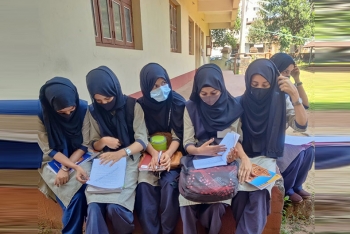
.png) Dr Suresh Mathew
Dr Suresh Mathew

Muslim girls wear hijab or headscarf; Sikh boys don turban; Catholic nuns wear habit. One gets to see this diversity in dress in schools and colleges across the country. It has never been an issue until a government college for girls in Udupi in BJP-ruled Karnataka refused entry to students, wearing hijab, into their classrooms. Adding fuel to fire, a few more colleges in the State followed suit. In one college, the girls wearing hijab were asked to sit in a separate classroom earmarked for them. The Karnataka government stoked more controversy by issuing a circular stating that ‘clothes which disturb equality, integrity and public law and order should not be worn’ by the students.
The storm over hijab took a turn for the worse with Hindu students, with uninhibited support of outsiders, decided to wear saffron scarves. As the protests spread like wild fire, the government closed the schools and colleges for a few days to douse the fire. The hijab issue was non-existent in Karnataka, as in other States, till it was raked up by the Udupi college. The only explanation to this disruptive decision of the college is that hijab goes against the uniform dress code. But it does not throw light on what prompted the authorities to take a U-turn from a practice that exists not only in Karnataka but in other States too.
Hence, the only plausible reason for this injudicious and ill-advised decision could be political intervention to sow the seeds of polarization in the society. Splitting people on the lines of religion, caste, creed and region has become a short-cut to power. In the process, even classrooms have become casualties. Those blinded by fanaticism have no qualms in intruding into the temples of learning. At a time when the country is witnessing elections in five States, some forces seem to polarize the society to inflate their vote bank. It is also a means to divert the attention of people from the pressing problems plaguing the country.
It is equally important to look into the argument that students should use uniforms in educational institutions. No one questions this, but adding a hijab or turban to the uniform does not compromise this. At best, one can say that the additional dress should be of the colour prescribed by the educational institution to match its uniform. It is important to distinguish hijab from burqa or veil which covers the face of the person. Hijab is nothing more than a headscarf, wearing of which does not fall under the frequently raised argument of security threat. It is as much a religious marker as a Sikh turban or Catholic nuns’ habit.
It is unfortunate that uniformity in classrooms is looked through the lens of religion and politics. The young minds, resonating with inclusiveness and unity sentiments, are poisoned and indoctrinated, with divisive thinking. One has to read the reported replacing of Tricolour with saffron flag in another educational institution in Shimoga in Karnataka along with the hijab issue. It reinforces the suspicion that school premises are being turned into laboratories to test how far the innocent minds have become fertile fields for fanaticism and fundamentalism. Yet another development is the statement of Karnataka Minister K. S. Eshwarappa who had the audacity to say that in future the saffron flag might become the national flag. These are clear indications of the direction to which the country is hurtling down.